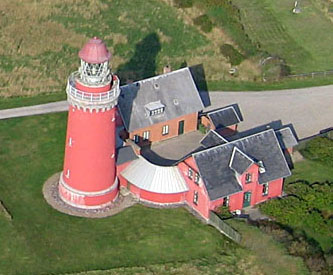
| KAP in Denmark

J.S. and S.W. Aber
Irene Marzolff
|
Introduction
In mid-September 2005, we had the opportunity to visit Denmark for professional reasons, so we took along our KAP gear. We took two camera systems--Canon digital Elph and Canon S70, which are both compact, easy to pack and transport, and perform reliably under various field conditions. Our rigid kites were packed in a golf-club case, which passed through airport security without arosing any suspicion. We rented a small minivan for transportation around the Danish countryside.

| Equipment packing for the trip from the U.S. to Denmark. Waterproof camera backpack (upper left), small cargo box, golf-club case, and waterproof camera case (lower right). |

| Flying the Sutton Flowform 16 over a field next to Jernhatten with our rented Opel Zafira. |
During our stay, we encountered a wide variety of weather conditions ranging from clear sky and optimum KAP wind to cloudy, rainy days, intervals with no wind, and times with too much wind. For most sites, our large rokkaku was utilized, and we also employed a large delta and a smaller Sutton Flowform 16 a few times. Given its maritime setting, Danish wind is generally consistent in speed and direction with little gustiness.
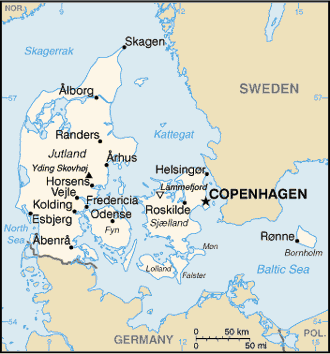
Map from CIA World Factbook.
Our efforts dealt with geological, historical and archaeological sites in Jutland, the mainland peninsula that makes up western Denmark (Eriksen and Olesen 2002; Lysdahl et al. 2003). From our base in Århus on the eastern coast, we travelled throughout the northern portion of Jutland, from the North Sea coast on the west, to the Skaggerak on the northwest, to the Kattegat on the east, and to the northernmost point at Skagen.
We were joined for part of this venture by Irene Marzolff, our KAP colleague from the University of Frankfurt, Germany. Special thanks to Holger Lykke-Andersen, who made logistical arrangements for this trip. The following sites are arranged geographically, starting in the north and proceeding to the northwest, west, central, and finally eastern portions of northern Jutland.

Skagen
Skagen is a narrow peninsula that extends to the northeast and separates the Skaggerak from the Kattegat seas. It's a prominent navigation point for passing ships. Given its geographic importance, several generations of lighthouses have been erected beginning in the late 1700s. Skagen is a low, sandy, wind-swept landscape with long beaches and active sand dunes. It is a famous scenic and touristic locale.
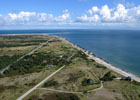
| View northeastward toward Grenen, the sandy tip of Skagen. The brick lighthouse just in front of Grenen is the "new" one built in 1858. It is still in operation today. Boulder barriers protect the coast from erosion during storms. |

| Closeup view of the lighthouse and sandy tip at Grenen. Here the Skaggerak sea (left background) meets the Kattegat sea (right). |

| View toward north showing a military radar station (domes). The white tower in center distance is a modern, automated lighthouse. Two ships are visible in the left background. |

| View toward the southwest over the city of Skagen. Hvide Fyr (white lighthouse) is the tower in lower right corner. Red tile roofs are traditional in Denmark. |
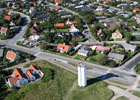
| Closeup view of Hvide Fyr, the white lighthouse. It was built in 1816 and is now a historical monument. |

| Reconstruction of the original Skagen lighthouse dating from the late 1700s. A fire burned in the basket suspended on the boom. |

| View southward over the harbor and industrial sector of Skagen. |
Mårup Kirke, Skaggerak coast
Built in the first half of the 1200s, Mårup Kirke is a brick structure that spans the transition from late Roman to early Gothic styles. However, coastal erosion during the centuries has brought the cliff perilously close to the church, and it was closed in 1926. In 1808 an English ship, the Crescent, wrecked nearby, and the ship's anchor was later brought to the church. Today the church is a historical monument.

| Overview of Mårup Kirke in the foreground and Skallerup Strand community in the background. The cliff is composed entirely of unconsolidated sediments. It's retreating at an average rate of 1 m (3 feet) per year. |

| Closer view of Mårup Kirke. Notice how the cliff has cut into the corner of the church yard at scene center. The large anchor in front of the church was recovered from a shipwreck in 1808, and dead sailors were buried in the church yard. |
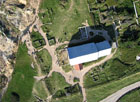
| Vertical view of Mårup Kirke. The anchor rests within the foundation of the former church tower. |

| Vertical view of the cliff and beach at Mårup Kirke. Notice two people (and their shadows) on the beach. |

| Sun glint view along the coast toward the southwest. Sand dunes and the abandonned lighthouse at Rubjerg Knude are visible on the left horizon. |
Feggeklit, Mors
Mors is a relatively large island within the Limfjord estuary of northwestern Jutland. Most of this region is underlain by unusual strata, called moler (mo-clay), which consists of interbedded volcanic ash and diatomaceous clay. This material was highly suspectible to deformation by advancing glaciers during the ice age. Moler is also highly valued for making ceramic products, including fire bricks for wood-buring stoves.
Feggeklit consists of a small ice-shoved hill that is connected as a narrow peninsula to the main portion of Mors. A cliff section on the eastern side of the hill reveals strongly deformed moler that was thrust up from beneath the floor of the Limfjord.

| Northward overview of Feggeklit, a cliff section on the east (right) side of scene, which is part of a long, narrow peninsula within the Limfjord estuary. Cattle are grazing on low, wet meadows in lower left corner of view. |

| Closeup view of Feggeklit. The coastal cliff is eroded on the side of a flat-topped butte of soft bedrock shoved up by glacier advance during the ice age. Notice the series of rock structures placed to control erosion on the west (left) side next to the highway. |
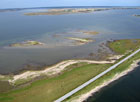
| Shallow Limfjord estuary and wetlands. The low-lying land has emerged from below the sea during the past few 1000 years, as the crust rebounded following the end of glaciation. |

| View toward southwest over the island of Mors and Limfjord. Factory in right background is a brickworks. Kite flyers are visible at bottom center of scene, along with the kite line. |

| Sun glint through partly cloudy sky highlights wave patterns on the Limfjord. |
Hanklit, Mors
Hanklit is a famous cliff located on the northern side of the island of Mors. The cliff displays large folded and thrust blocks of moler strata of the same type seen in Feggeklit (see above). Hanklit is eroded on the end of a large ice-shoved ridge that was created during the last glaciation of northern Jutland. This impressive cliff and the beach at its foot attract many tourists.

| Northeastward overview of the Hanklit vinicity on the north side of the island of Mors. A patchwork of agricultural fields covers the land area, and a small gravel beach runs along the coast of the Limfjord. |

| Closeup view of Hanklit, a large coastal cliff (left of center) that exposes the internal structure of deformed bedrock and sediment in a large ice-shoved ridge. |

| Coastal and agricultural features in vicinity of Hanklit. This area is quite popular for summer tourism, and many recreational homes have been built or restored in the neighborhood in recent years. |

| View westward from Hanklit over harvested fields in the ice-thrust terrain of northwestern Mors. Wheat and barley are the main grain crops. |
Bovbjerg Klit, North Sea coast
Bovbjerg Klit is a cliff on the North Sea coast of western Jutland. The cliff marks the terminal limit of the last glaciation in Denmark, the so-called Main Stationary Line, where an ice sheet from central Scandinavia reached its maximum extent. Along this line, a moraine accumulated to create a higher, hummocky landscape, which is now eroding along the cliff. At the top of the cliff, a lighthouse is threatened by continued cliff erosion. Updrafts along the cliff are utilized for flying model airplanes and gliders.

| Overview of Bovbjerg Klit, a coastal cliff section on the North Sea, with the village of Borup and Ferring Sø lagoon in the background. |

| Closeup view of Bovbjerg Klit lighthouse. This brick structure dates from 1877; however, due to rapid cliff erosion its life is now limited. |

| Coastal erosion of the cliff at Bovbjerg Klit. The cliff stands 44 m (~150 feet) high and is composed entirely of unconsolidated glacial sediment. The boulder structures are designed to slow beach erosion. |

| Vertical view of gully erosion patterns on cliff; beach to left, cliff top to right. |
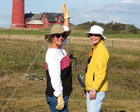
| Irene Marzolff (right) and S.W. Aber adjust the camera rig on the kite line near the lighthouse at Bovbjerg Klit. |
Ramme Dige, western Jutland
Ramme Dige is a well-known archaeological site located near Bovbjerg Klit (see above). It includes a cluster of burial mounds dating from the Stone Age and Bronze Age, as well as a wall-ditch structure that extends more than 2.5 km (~1½ miles) long. The wall and ditch were built for defense during the middle Iron Age, presumably A.D. 200-400 interval.

| Overview of burial mounds with sheep grazing between the mounds. Features at lower left and center appear to be "double mounds" with a surrounding edge. The others are single mounds. |

| Closer view of the main cluster of burial mounds. Sheep grazing inhibits growth of woody vegetation that would otherwise cover the protected site. Linear patterns are old field boundaries. |

| Closeup detail of one of the "double mounds" in which the center of each mound appears to have collapsed or been removed. |

| View toward the east showing remains of a wall (>) to left and a single burial mound (<) to right. Numerous wind turbines are visible in the background. |

| Detailed view of the preserved wall and ditch in the foreground and its continuation as a grassy stripe across a field in the left background. |
Gammelsogn Kirke, near Ringkøbing
Gammelsogn Kirke (old parish church) dates from the 1170s, when the Roman nave and choir were built. The interior of the church displays frescos from this time. The tower and entry house were added later. The church stands beside a tiny beach on Ringkøbing Fjord, a large lagoon on the western coast of Jutland. The beach was used for landing small boats by local residents until 1869, when a new church was built at Nørre Lyngvig. Next to the church is the old parish school building.
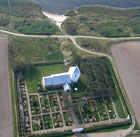
| Overview of Gammelsogn Kirke, the surrounding church yard with graves, and the tiny beach on Ringkøbing Fjord. Kite line and flyers are visible in the upper left corner. |
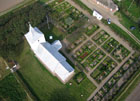
| Closeup oblique view of Gammelsogn Kirke and the surrounding church yard. |
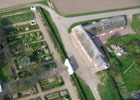
| Old parish school building (right) next to Gammelsogn Kirke. |
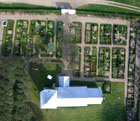
| Vertical view of Gammelsogn Kirke and the surrounding church yard. Notice the shadows cast by the church building and the gate (top of view). Also note the slight shift in alignment between the nave and choir of the church building. This was done on purpose to avoid perfection in the church structure. |
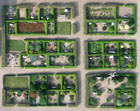
| Detailed vertical view of carefully groomed grave sites beside the church. Each family plot is surrounded by a hedge and decorated with ornamental shrubs and flowers. |
Vinderupvold
Vinderupvold is a middle-age fortress ruin situated next to the city of Vinderup in central Jutland, near the southern margin of the Limfjord. The site was first mentioned in 1274, and the fortress presumably was built in the early 1300s. At this time, central authority of the Danish court was weak, and local nobles felt the need for strong protection. Many such fortifications were constructed in Denmark (see another example from Helgenæs below). The fortress originally had two wall-ditch enclosures, as was often common for such structures. The site has been protected since 1936.

| Overview of the city of Vinderup looking toward the east. |

| Residential neighborhood on the western edge of Vinderup. |

| Overview of Vinderupvold historical site. Features include: a) central mound, b) inner moat or ditch, c) smaller square outside the moat, and d) possible outer ring (former moat). Sheep are grazing in the right background. |
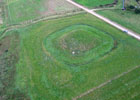
| Closer overview of Vinderupvold. Note the drainage ditch, Landting Å, in the right background, which has lowered water level in this wetland site by at least 2 m (6 feet). Kite flyers standing in left background. |

| Detailed view of Vinderupvold. The while speckles to left are patches of wildflowers. |

| Relationship of Vinderupvold to remaining wetland on left side of view. |

| Detailed view of ponds and wetland vegetation next to Vinderupvold. Notice the spoil piles next to the drainage ditch, Skærbæk Å, along top of view. Kite flyers standing at upper right. |
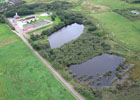
| Sewage treatment plant (upper left), ponds and wetland near Vinderupvold. |
Helgenæs, east of Århus
Helgenæs is a large ice-shoved hill that is connected to the mainland by an esker, a narrow ridge of sand and gravel deposited by a subglacial river. This scenic area is located on the eastern side of Århus Bay. The peninsula is a mosaic of private and public areas, and it has many summer and weekend homes. The hilly landscape reaches nearly 100 m height and is surrounded by beaches and cliffs. There are many walking, bicycle, and horse-riding paths.

| Lighthouse at Sletterhage, southern tip of Helgenæs peninsula. The lighthouse dates from 1894. |
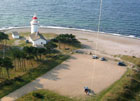
| Closeup, low-height view of lighthouse. Kite flyers are standing at bottom of scene. |
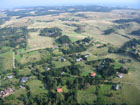
| View from Sletterhage northward over the hilly landscape of Helgenæs. Many summer and weekend homes are visible in the foreground. |

| Two-masted yacht sailing toward sunrise on the sea east of Helgenæs. |

| Olaf Ryes Skanse, remains of a middle age wall and fortress on a hill, at the northern end of Helgenæs peninsula. View southward. |

| View northward to the hilly mainland of Mols Bjerge. This region is famous for its scenic beauty. |
Jernhatten, east of Århus
Jernhatten (the iron hat or helmet) is an isolated hill on the Kattegat coast east of Århus. A parking area near the hill allows access to a walking path that leads to the beach and to the hill top. From the top, there is an excellent view of the sea, beach, and adjacent agricultural landscape. This site is popular for nature walks.

| View of Jernhatten hill top. The hill stands 49 m (~160 feet) above sealevel and provides an excellent view of the surrounding landscape and sea. |
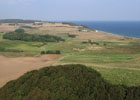
| View of the Kattegat coast and landscape north of Jernhatten. |

| September is the time for cultivating soil and planting winter crops. Here a tractor is working a field. |

| Tractor and trailer on the road next to Jernhatten. |
Kites and wind power in Denmark
The wind blows from the sea most days in Denmark, and the country is famous for all activities associated with the wind. Kites are popular in many forms, as we observed during our short stay. Of greater economic significance is electrical power generated by hundreds of wind turbines. In fact, the manufacture and export of wind turbines has become a major component of the Danish economy. The largest wind turbines stand 100 m tall; they turn slowly, do not make much noise, and disturb wildlife little. One way to judge the wind speed for KAP is to watch the large wind turbines. The blades should revolve once in 3-4 seconds for optimum KAP conditions.
References
- Eriksen, P. and Olesen, L.H. 2002. Fortiden set fra himlen: Luftfotoarkæologi i Vestjylland. Holstebro Museum, Denmark, 160 p.
- Lysdahl, P. et al. 2003. Arkæologiens Nordjylland. Midt-Nord Turisme, Aabybro, Denmark, 88 p.
 Return to KAP gallery.
Return to KAP gallery.
Last update: Jan. 2007.





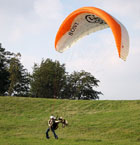

![]() Return to KAP gallery.
Return to KAP gallery.